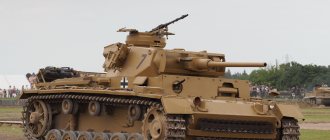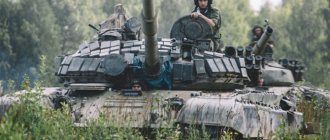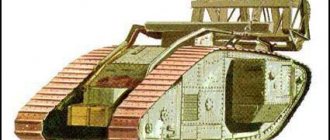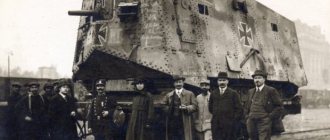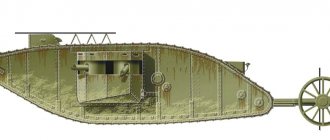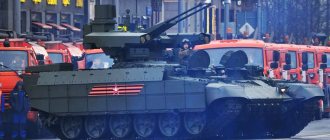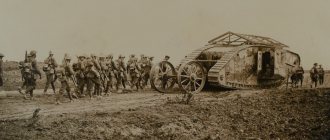The size of the Tsar Tank is impressive! Photo: Zvezda Channel
Let's start from the middle. Realizing that not all of our readers are military experts, I’ll still ask: after looking at the illustrations, tell me: where is the most vulnerable spot of the Lebedenko tank? That's right - its nine-meter wheels on spokes: a tank the height of a three-story building is an excellent target, and just a few ordinary cannon shells will disable it.
But who paid attention to such trifles, if the highest permission and 210 thousand rubles were literally given to the developer by Nicholas II himself?! First, the project was looked at by the head of the Union of Zemstvos and Cities, Prince Georgy Lvov, who is also not a great engineer. But it was he who achieved a personal audience with the emperor. The meeting took place on January 8 (January 21), 1915. Lebedenko came to it with a well-prepared presentation in the form of a wooden model of his car with an engine based on a gramophone spring. The courtiers recalled: the emperor and the engineer, “like little children,” crawled on the floor for half an hour, and the toy ran on the carpet, easily overcoming the stacks of volumes of the “Code of Laws of the Russian Empire” piled on it.
general characteristics
In fact, Lebedenko’s tank, the photo of which looks very unusual, is not a tank in the usual sense of the word. Rather, it is a wheeled combat vehicle. In addition to Nikolai Lebedenko, N. Zhukovsky and his two nephews, A. Mikulin and B. Stechkin, took part in its development. Based on the results of tests carried out in 1915, the tank was declared unsuitable for use in real combat. As a result, the project was closed. Later, the completed copy was dismantled for scrap. Despite the complete failure of the Lebedenko tank, it went down in history as an extremely bold and extraordinary project. It is thanks to the originality of this combat vehicle that it is remembered to this day.
Lebedenko tank
Lebedenko tank
Another interesting vehicle manufactured in Russia during the First World War was the Lebedenko tank. It is mentioned in almost all works on the history of domestic tank building, often with loud (but not actually existing) names: “Tsar Tank”, “Bat”, “Mastodon”. As in the case of the All-Terrain Vehicle, the history of this vehicle over the years has become overgrown with many speculations and legends.
Inventor Nikolai Nikolaevich Lebedenko (sometimes in literature he is called captain, which is not true) began designing a wheeled combat vehicle in 1916. It was assumed that with a mass of 35–40 tons it would be able to reach speeds of up to 15–17 km/h. The vehicle was supposed to be designed in the form of a giant gun carriage with a wheel diameter of 9 m. It was believed that with such parameters it would easily overcome trenches, walls and other obstacles.
Unfortunately, little information was found about Lebedenko himself. It is known that he had his own private (that is, private) laboratory, which was located in Moscow, in a mansion on Sadovo-Kudrinskaya Street. In 1914, Lebedenko took on the design of a bomb release device for the Ilya Muromets aircraft; he also carried out other orders from the military department. It is known that Lebedenko knew Professor N. Zhukovsky well - they met before the war, at the XII Congress of Naturalists and Doctors, where Zhukovsky was the chairman and Lebedenko the secretary. Therefore, it is not surprising that when the latter needed help, Zhukovsky not only did not refuse, but also recommended his nephews for this - students of the Moscow Imperial Technical School (now Bauman Moscow State Technical University) B. Stechkin (later a famous designer of aircraft engines ) and A. Mikulina (later an academician, a prominent scientist in the field of aeromechanics and thermal engineering).
Lebedenko tank, general view (CMVS).
Lebedenko decided to look for funds to build his car not from the military - perhaps he assumed that it would not be easy, and the business might not work out), but from the Union of Zemstvo Cities. It is possible that this step was due to the acquaintance of the Chairman of the Union, Prince Lvov, with Professor Zhukovsky, although, perhaps, there were some other reasons. But the fact remains that the Lebedenko tank was NEVER considered by the Main Military-Technical Directorate; its production was carried out without the control of the military department.
After carrying out preliminary calculations, Lebedenko, Mikulin and Stechkin made a wooden model of the machine with 30-centimeter nickel-plated wheels and a drive from a gramophone spring. Placed in a luxurious mahogany casket, it was shown to Prince Lvov, through whom Lebedenko achieved the Highest audience. The model made a favorable impression on Nicholas II: on the floor in the emperor’s office, she “easily overcame ‘obstacles’, climbing the thick volumes of the Code of Laws of the Russian Empire.” Nicholas II asked to leave the model for him and ordered the opening of financing for the project. As a result, the Union of Zemstvo Cities allocated a considerable amount for that time - 210,000 rubles - for the production of a combat vehicle.
Production of the tank began at the end of 1916, with the assembly of parts carried out in separate sections - this is exactly how it was supposed to be done at the front. The sections were assembled in Moscow, in the arena near the Khamovniki barracks, and they decided to assemble the machine itself not far from Dmitrov, near the Orudevo railway station. Wooden barracks and special platforms were built here, and a workshop was equipped.
The assembly of the machine was completed only in August 1917, since technical and technological problems arose during the manufacture of a number of parts. The assembled tank was amazing in its size. It had a body riveted from 6 mm non-armored steel (in the terminology of that time - boiler iron) on a frame made of a metal profile. Each 9-meter running wheel was driven by a separate Maybach engine with a power of 240 (according to other sources 210) hp. at 2500 rpm. The engines were removed from a damaged German Zeppelin airship (most likely from the Zeppelin L-38, which made an emergency landing in Courland on December 29, 1916). The wheel with spokes, designed for strength by Zhukovsky, had a T-section. Two rollers with car tires were pressed against the side shelves of the brand, covered with wooden boards, with the help of a railway spring, which, rotating towards each other, turned the road wheel due to friction. The transmission of rotation from the engine shaft to the rollers was carried out through bevel gear pairs. The rear wheel of a smaller diameter, resting on the tail frame, could turn on a special hinge, but was not steerable. The rotation of the entire machine was carried out due to different speeds of rotation of the road wheels by increasing or decreasing engine speed.
As for the vehicle’s armament, precise information about it could not be found (there are mentions of several machine guns and two guns without specifying the caliber). It was supposed to be installed in the side sponsons and a turret located in the central part (the turret did not rotate).
Tests carried out in August 1917 showed the vehicle's low speed, inconvenient control and poor maneuverability - the rear swivel wheel got stuck, and it was necessary to increase its diameter. In addition, the friction transmission to the road wheels was ineffective when the wheels got stuck or got wet, causing the tires to slip. In addition, it turned out that the power of the installed engines was clearly not enough for such a massive machine.
Lebedenko did not modify his car, and in the fall of 1917 he left for America without submitting a report on the amount of money spent on the construction of his tank.
Most publications about this combat vehicle, as a rule, say that it made only one trip and, having broken a birch tree, got stuck, after which the tests were stopped. However, as follows from the documents, the Lebedenko tank was also tested under Soviet rule. Thus, on February 23, 1919, the Main Armor Directorate of the People's Commissariat for Military and Naval Affairs sent the following report to the Extraordinary Commission for Supply of the Red Army:
“According to inquiries made to the Committee for Inventions of the Supreme Economic Council (Supreme Council of the National Economy. - Author’s note
), the HH Lebedenko tank has the following properties:
1). The armor is easily penetrated through (1/4 inch boiler iron);
2). The third wheel on the trunk is small in size, which causes high specific pressure and inevitable jamming;
3). The weight of the tank is colossal - 2,400 pounds (38,400 kg), and no bridge (except a railway one) can support it;
4). Friction transmission of motion is not applicable for such a heavy structure;
Lebedenko tank, left view. The size of the car can be imagined by comparing it with the figures of people standing nearby (CMVS).
5). The speed that the Committee for Inventions of the Supreme Economic Council managed to achieve when testing this tank reached only 3 versts per hour.
Currently, the tank and its approaches are covered with snow over a long distance. The Main Armor Directorate considers the HH Lebedenko tank to be uncombat-ready and not subject to use for combat missions due to its specified properties, and the cost of excavating the tank to test it is unproductive, which is aggravated by the fact that it is undoubtedly rusty.
If the Red Army Emergency Supply Committee still deems it necessary to carry out a test, then the Main Armor Department will submit an estimate for its implementation.
Head of the Main Armor Directorate (signature)
Commissioner of the Main Armor Directorate (signature).”
For several more years, torn to pieces, the one-of-a-kind wheeled combat vehicle stood alone in the forest, frightening passers-by with its size. In 1923, it was finally dismantled for metal.
Idea
According to the memoirs of Nikolai Lebedenko, he was inspired to create such an unusual design by carts, which were used in Central Asia and, thanks to their huge wheels, could easily overcome off-road conditions. Thus, the Tsar Tank differed from the usual tanks, which use caterpillar tracks for movement, primarily in the presence of wheels. In design, it resembled a gun carriage, greatly increased in size.
Design
A pair of huge front spoke wheels of the Lebedenko tank, the photo of which is striking in the scale of the design, had a diameter of about 9 meters. The diameter of the rear roller was significantly smaller - about 1.5 meters. The upper machine-gun house was stationary and located at a height of about 8 meters. The width of the T-shaped box-shaped body was 12 meters. At its extreme points, protruding beyond the planes of the wheels, sponsons with machine guns were installed. In addition, the possibility of installing guns was assumed. It was planned to install an additional machine-gun turret under the bottom of the hull. The design speed of the vehicle was 17 km/h.
Project of the first Russian tank
The plan to create a unique tank on wheels was born by engineer Nikolai Lebedenko in 1914. At that time, Nikolai Nikolaevich was the head of the laboratory of military inventions. At its base they were developing devices for dropping bombs for the Russian bomber Ilya Muromets. But at the same time, the Russian army also needed ground equipment capable of frightening and defeating enemies.
Lebedenko’s Tsar Tank, so named by analogy with the Tsar Bell and the Tsar Bath, became precisely this type of equipment. Strictly speaking, it was not a tank - instead of tracks it had spoked wheels. It turned out to be a kind of huge chariot with guns mounted on it. And it is worth saying that it was truly a masterpiece. A carriage rested on nine-meter wheels, and on it stood four machine guns and two cannons. At the back of the first Russian tank there was a small cart with small wheels. By the way, the car could reach a speed that was good for those times - about 17 km/h. A team of ten people had to operate such a colossus and load its guns.
After the project was developed, little remained to be done. Lebedenko and his team had to raise money to develop a prototype. And for this, the engineer turned second-hand to Emperor Nicholas II himself.
Confession
Surprisingly, despite all the complexity, unusualness and enormous dimensions of the vehicle, the designer Lebedenko was able to convince the highest authorities of its suitability for use in real combat. The tank was approved by a number of government bodies, but it received its main assessment on January 8, 1915 during an audience with Nicholas II. The designer presented the emperor with a smaller wind-up model of his tank, made of wood, with an engine based on a gramophone spring. According to the memoirs of courtiers, the emperor and the engineer “crawled across the floor like little children, chasing the toy around the room.” The wooden tank moved briskly across the carpet and easily overcame stacks of several thick books. As a result, the emperor, impressed by the machine, ordered funding for the project to begin. 210 thousand rubles were allocated for the creation of the Lebedenko tank.
Tests
On August 27, 1915, the tank was completely ready and passed its first tests. Thanks to the use of huge wheels, the device had increased maneuverability - it broke birch trees in its path like matches. However, the rear roller, due to its small dimensions and improper distribution of the machine’s weight, almost immediately got stuck in the soft ground. Large wheels, even despite the use of a very powerful propulsion system for those times, could not pull it out. By the way, on the Lebedenko tank developed in 1914-1915. there were two captured engines. Each of them developed a power of 240 horsepower, which significantly exceeded the power of the power plants of Russian tanks of that time. These engines were removed from a damaged enemy airship.
In addition, the tests revealed a significant vulnerability of the machine, which would later seem obvious. The weakest link in the design were the wheels, which quickly became unusable in the event of enemy shelling with high-explosive shells.
As a result of far from the most successful tests, the project was closed in September 1915. The official reason for this was the negative conclusion of the High Commission. Despite the closure of the project, Stechkin and Mikulin continued to develop it and tried to create a new engine for the tank. However, their efforts came to nothing, as did attempts to move the tank stuck in the ground and take it out of the testing area.
Until 1917, Lebedenko’s tank stood at the test site under guard, until it was forgotten due to the outbreak of political problems. For another seven years, the huge combat vehicle rusted in the forest. In 1923, it was dismantled for scrap metal.
Armored cars in defense of France
First World War, 1914.
The parties had not yet settled into the trenches, but were furiously trying to outmaneuver each other. The first French armored cars went into battle. Everything was done in haste, the French armored Renault and Peugeot cars and equipped them with cannons and machine guns. Already in the fall of 1914, the first French armored unit entered the battle.
But trench warfare on the Western Front made armored vehicles almost useless.
And soon His Majesty the Tank appeared on the stage.
The French built slow-moving Schneiders and monstrous Saint-Chamons until Louis Renault showed the whole world that a tank could be small but remote.
Of course, Renault tanks set the layout for a hundred years to come. But the French also did not abandon wheeled vehicles, despite their most massive tank fleet in the world after the First World War.
During the interbellum, no one really knew what the war of the future would be like (and few doubted that it would be) and how to use armored forces in it. Everyone experimented at their best. Thus, a series of half-track armored vehicles was built on the basis of the developments of Adolf Kegress, a mechanic at His Imperial Majesty's garage, who quickly left revolutionary Russia.
But in the early 30s, by order of the cavalry, she developed the Panhard 178 vehicle, or AMD-35 according to the army classification. All-wheel drive, two control stations, 25-mm Hotchkiss cannon (based on a light anti-tank gun) with good penetrating effect, coaxial machine gun. The frontal armor reached a respectable 26 mm for an armored car.
But France was rocked by crises and strikes. The release of the car was delayed. When German panzers began to crush the border posts on the Belgian border, there were only 217 units of such equipment in 11 squadrons.
Armored car AMD-35 (Panar 178)
During May-June, production began to resemble a fire in a cabaret.
There was a shortage of turrets, and a couple of dozen armored cars were equipped with hastily made cabins without a roof with slots for light machine guns. However, they couldn’t change the weather anymore. Just as thousands of thick-skinned tanks did not help save us from defeat.
A German soldier examines a damaged AMD-35
AMD-35s in reconnaissance squadrons and reconnaissance regiments of tank and mechanized divisions performed very well, performing in battles with German armored cars - and even tanks - almost on an equal footing. Machine gun Pz. I actually had a Panaro by one tooth.
The Germans also appreciated the fashionable cars and took a couple of hundred for themselves into the Wehrmacht and SS. Some of them became armored tires and acted against partisans in the occupied territories.
Soviet soldiers inspect a captured Panhard, converted into armored tires
In 1944, some of the Panhards, including those without towers, fought in Free French units.
Project evaluation
In general, the fate of the Lebedenko tank developed in 1914-1915 is similar to the fate of almost all prototypes that were developed in those days. Due to the lack of both established canons in the design of this kind of machines, and any of their concepts, they all ended their existence in a very prosaic manner. This can partly explain the paradoxical situation when a very ambitious and promising project receives approval from high authorities, but in fact remains just a pile of metal.
Already at the first test, the incredible vulnerability of the tank was revealed - a regular volley of shrapnel aimed at the wheel spokes would disable the vehicle. Moreover, due to the colossal size of the tank and its low speed, it was an excellent target. The dimensions of the vehicle predetermined its low cross-country ability. A covert transfer of tanks to the front line was unlikely.
Jean, they're in the trees!
After the war, it was necessary to revive the state and the army. It was decided to return to the release of the much-loved AMD. Only the new turret was designed for the 47 mm SA-35 gun - the 25 mm gun was clearly not enough.
In 1950, a couple of dozen Panhard 178Bs went to rebellious (as the French thought) or revolutionary (as the Vietnamese thought) Vietnam. There, young Vo Nguyen Giap gave the colonialists a hard time, learning guerrilla warfare in the jungle on Gaul cats. There, armored cars were very useful when escorting convoys and convoys, which Vietnamese independence fighters often ambushed. Later, the Americans experienced these skills the hard way.
Panhard 178 in Indochina
The fight went on with varying degrees of success, but Dien Bien Phu happened.
Merde! Things went wrong with Vietnam.
The French still did not give up trying to preserve the remnants of the colonies - “Panhards” came in handy in Algeria, Morocco and many other places. Veterans served until 1964. After which the gullible Syrians managed to shake off the party.
Psychological weapon
The Lebedenko tank, even if it had been mass-produced, could only be used as a psychological weapon. Definitely, the vast majority of soldiers of those times could only see such a machine in a nightmare. Military history shows that such intimidation mechanisms should definitely not be written off. During the Second World War, for example, Soviet soldiers were very successful in forcing the enemy to retreat by “dressing” simple tractors in wooden frames shaped like tanks. However, mass production of this kind of machines in those days was in itself unlikely. The main reason for this was the shortage of powerful engines. And it is unlikely that the country would have mastered such production.
Project result
The final “debacle” of the project was due to the fact that the creation and construction of the Lebedenko tank had practically no impact on domestic (and even more so global) tank building. The combat vehicle became another dead-end attempt in the development of an industry that at that time was making its way into the world mainly through trial and error.
The only positive result from this project was the experience gained by young designers Mikulin and Stechkin. When it was found that the power of the tank's power plant was not enough, they developed a new engine, called AMBS-1. This engine implemented advanced solutions for that time, for example, direct fuel injection into the cylinders. Both designers later became outstanding specialists in the field of aircraft power plants and members of the USSR Academy of Sciences.
What exactly was the largest tank in the world?
After completion of construction, the “Bat” was amazing in size. The height of the monster was equal to a three-story house. In addition, the car weighed almost 60 tons. Externally, the tank looked more like a huge carriage: a machine for artillery guns. On the platform between the wheels rested two turrets with machine guns. According to the designers, such a monster, despite its weight, could accelerate to 17 kilometers per hour on the highway. For comparison: the maximum speed of the car at that time barely reached 60 kilometers per hour. And here we were talking about a sixty-ton giant.
An unusual “heart” was beating inside the “Bat”. The Russian tank was powered by two German Maybach engines, which were obtained during the battles. Moreover, each engine had a power of 240 horsepower. The Maybachs were removed from the stricken airship. No car in the world at the beginning of the 20th century had such power. And it was precisely this kind of power that was required for the Bat’s wheels to break trees like matches.
It was decided to assemble the Tsar Tank secretly. In the forest, near the village of Orudevo, engineers worked in several shifts. As a result, the forest became a restricted area. There were military personnel around the assembly site. Any attempt to penetrate the cordon was brutally suppressed. Parts for the tank were manufactured by factories located in Khamovniki. The vehicle had outstanding armor - heavy sheets of steel. The first tests showed that the tank had incredible maneuverability. However, subsequent trials ended sadly.
After the construction was completed, they tried to leave the forest by car. As soon as the tank slid off the log deck, problems began. The rear roller hit the soft ground and was firmly stuck. How to pull a sixty-ton monster out of the ground? It turned out that this was impossible to do. Moreover, the Tsar Tank could not even be lifted. There were two options left: leave the miracle of technology in the forest or throw all your efforts into modernizing it. The designers adhered to the second point of view. Mikulin and Stechkin even set about creating a new, even more powerful engine. They were convinced that with his help the machine would pull itself out of the trap. But a bold decision required investment. But there was no free money in the treasury at that time.
Model of the Tsar Tank
Interesting Facts
There are many interesting facts associated with this extraordinary car. Here are just the main ones:
- Among other nicknames, Nikolai Lebedenko’s tank was called “Bat” or “Bat”. The fact is that when carried by the rear wheel, the car really resembled the shape of a bat that sleeps upside down on a tree branch or a cave wall.
- The wooden model that designer Lebedenko made to demonstrate his developments to the emperor was kept by Nicholas II for himself. The further fate of the model is unknown.
- There is a legend about a conspiracy, the main link of which was the Tsar Tank. According to it, the obviously failed idea of the machine was intensively lobbied by high-ranking persons acting in the interests of England and serving in the Russian General Staff. In accordance with this version, these same officials put an end to the Porokhovshchikov all-terrain vehicle project, the drawings of which subsequently went to British engineers and formed the basis of the first English tanks. The external similarity of that same “all-terrain vehicle” with the Mk I series tanks speaks in favor of the latter hypothesis. However, these judgments do not have documentary evidence; moreover, the tracked propulsion system of English vehicles is very different from a similar element of the failed Russian vehicle.
- The forest in which the Tsar Tank was tested and then simply rusted was called “Tank’s forest” among local residents.
- The history of the development of the Lebedenko tank, the characteristics of which we are considering today, was described in the art-historical novel “Talent (The Life of Berezhkov),” filmed in 1956 by Alexander Bek. The film tells about the life and work of A. A. Mikulin, who is presented in it under the pseudonym Alexey Berezhkov.
- The designers of the IG-227 Hailfire missile tank, which was presented in the film "Star Wars II", were inspired by Lebedenko's Tsar Tank. The photo of the movie camera really resembles a Russian tank from the early 20th century. The fantastic tank differs only in that it does not have a rear roller, and the large wheels are at an angle to each other.
Specifications
Finally, we note the main tactical and technical parameters of the Lebedenko tank developed in 1914-1915:
- Crew – 15 people.
- Number of copies produced – 1.
- Weight – 60 tons (20 tons less was planned in the project).
- Length – 17.8 m.
- Width – 12 m.
- Height – 9 m.
- Type of armor – rolled steel;
- Armor thickness: forehead, side and rear of the hull - 10 mm/deg (planned 7); bottom, turret side and hull roof - 8 mm/deg (planned 5).
- Gun type: caponier.
- The caliber of the gun is 76.2 mm.
- The gun's ammunition capacity is 60 shells.
- The sights are optical.
- The machine gun model is “Maxim”.
- Machine gun caliber – 7.92 mm.
- The machine gun's ammunition capacity is up to 10 thousand shells.
- Engine type: high-sided aviation carburetor, Maybach brand.
- Number of motors in the power plant – 2 pcs.
- Engine power – 240 hp. at a torque of 2500 rpm;
- The speed of the car on the highway is 17 km/h.
- Speed on rough terrain – 10 km/h.
- Cruising range on the highway is about 60 km.
- Cruising range on rough terrain is about 40 km.
- Suspension type: rigid.
- Wheel formula – 3*2.
- The specific power of the tank is 8.3 liters. s./t (according to the project - 12.5).
